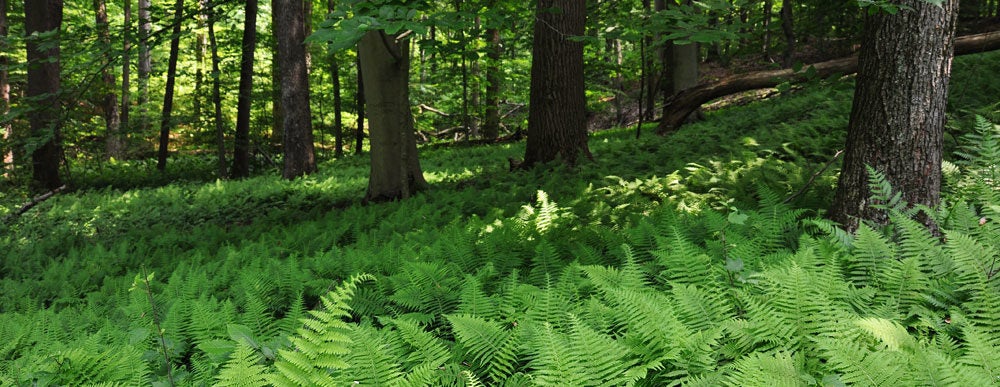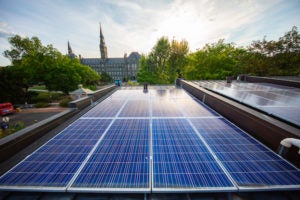50 Facts for 50 Years

FACTS ABOUT OUR PLANET – 50 FACTS FOR 50 YEARS
Georgetown students developed this list of 50 compelling facts about our planet as part of our effort to mark the 50th Anniversary of Earth Day. The numbers below show the challenges we face, but also offer an uplifting message of hope about the solutions that can be achieved when people come together to take action for our planet.

Waste
- 25% of the bottled water you buy is really municipal tap water, so you might as well pass on the plastic bottle.1
- Agriculture uses up 70% of our global freshwater. It goes up to 90% in fast-developing countries.2
- The US makes up only 5% of the world population, but it throws away enough plastic bottles in a week to encircle the Earth 5 times!3
- On average, ONE supermarket goes through 60,500,000 paper bags per year! Bring a reusable bag instead!4
- A modern glass bottle takes 4000 years or more to decompose.5
- The U.S. is the #1 trash-producing country in the world at 1,609 pounds per person per year. This means that 5% of the world’s people generate 40% of the world’s waste. We toss out two billion plastic razors, a million and a half tons of paper towels, and 12 billion disposable diapers annually.6
- The average college student produces 640 pounds of solid waste each year, including 500 disposable cups and 320 pounds of paper.7

Climate Change
- In the last 170 years, we added 2.4 trillion tons of Carbon Dioxide into our atmosphere. Half of this was added in the last 35 to 50 years.8
- The five warmest years on record have occurred in the last decade.9
- Transportation and housing make up about 60% of the carbon footprint of US households. This is due to the fuels used for transportation and to heat, cool and power our homes.10
- Scientists predict that if the increase in greenhouse gas emissions continues unabated, temperatures will rise by as much as 10 degrees Fahrenheit by the end of this century.11
- Although greenhouse gas emissions are primarily associated with the burning of fossil fuels (chiefly, coal, oil and natural gas), they come from many sources. As a result, any effort to reduce the human impact on the climate will need to engage all sectors of society.12
- Most emissions come from a relatively small number of countries. The seven largest emitters—the United States, the European Union (EU), China, Russia, Japan, India, and Canada—accounted for more than 70% of energy-related CO2 emissions in 2004.13
- As of 2018, the concentration of carbon dioxide (CO2) in our atmosphere was 408 parts per million — the highest it has been in 3 million years.14

Environmental Justice
- EDF and Google Earth Outreach teamed up to map air pollution threats on a block-by-block scale in West Oakland, California, to give communities actionable, empowering information that previously not even the government could provide.15
- Over 6 million people currently live in coastal areas vulnerable to sea-level rise at 1.5°C degrees, and at 2°C, climate change would affect 10 million more people by the end of this century.16
- Due to uneven distribution patterns, minority and low income communities have far less access to green spaces than white, affluent communities and have limited resources to maintain the green spaces they do have.17
- In 2015, about 54.4 million people (17.7% of total U.S. population) had low access to a supermarket due to limited transportation and uneven distribution of supermarkets.18
- Native Americans make only about 1% of the U.S. population and occupy about 4% of the land, but they disproportionately face dislocation and food shortages attributed to climate change.19
- Children living near freeways have shown to have substantial deficits in lung function, and they develop asthma exacerbations, increased risk of low birth weight, and premature birth.20

Solutions and Best Practices
- Recycling one aluminum can save enough energy to run a TV for three hours.21
- The Ozone Layer “Hole” which is 29 million square kilometers, is expected to be fully healed in the next 55 years. This is due to the worldwide banning of chlorofluorocarbon and hydrofluorocarbon.22
- The Carbon Neutral Cities Alliance (CNCA) is composed of 21 global cities with the common goal of reducing greenhouse gas emissions by at least 80% by 2050.23
- Say no to bags when you go shopping! A plastic bag is used for an average of 12 minutes but will remain in the environment for 1,000 years before it decomposes.24
- Up to 90% of the energy used during a washing machine’s cleaning cycle goes into heating the water, so use the cold setting.25
- Lighting accounts for 15% of global electricity use. Switching to LEDs will use 90% less energy and last far longer than with the use of incandescent lights.26
- The EU has banned 8 types of the most common single-use plastics, including plastic cutlery, straws, plates, and cotton buds made with plastic.27
- Agricultural emissions could be reduced by as much as 70% by adopting a vegan diet and 63% by adopting a vegetarian diet.28
- Germany has the best recycling rate in the world followed by Austria, South Korea, and Wales.29
- The Smog Free Project, headed by Daan Roosegaard, is a pioneering technology that removes smog from the air and turns it into jewelry.30

Conservation and Biodiversity
- The world’s indigenous population makes up just 5% of the global population yet protects 80% of global biodiversity.31
- Rainforests are being cut down at the rate of 100 acres per minute.32
- Around 20% of the world’s total oxygen is produced in the Amazon rainforest, where 1% of tree species sequester 50% of the region’s carbon. The forest has 16,000 different species of trees and is estimated to have nearly 400 billion individual trees. All of this arboreal magnificence sequesters between 90 and 140 billion metric tons of carbon. When we lose forest habitat, that carbon makes its way back into the atmosphere.33
- Despite the fact that Norway is over 6,000 miles from Brazil, the country donated a billion US dollars to help save the Amazon rainforest between 2008 and 2015. In fact, the Norwegians are the biggest benefactor in the world for protecting the tropical rainforests.34
- Tropical forests cover less than 7 percent of Earth’s landmass but are home to about 50 percent of all living things on the planet.35
- Forests are home to 50 million indigenous people around the world, more than the populations of Tokyo, Mexico City, London, New York City and Cairo combined.36
- In response to the first Earth Day in 1970, the U.S. Government created the Clean Air, Clean Water, Endangered Species Acts, and the EPA.37
- Soil is more than just dirt — it’s practically a living organism! One handful of healthy soil contains billions of micro-organisms that are critical to storing gases, breaking down and retaining nutrients, and growing healthy plants!38
- For oceans, oil spills aren’t the big(gest) problem. Headline-grabbing oil spills account for just 12 percent of the oil in our oceans. Three times as much oil is carried out to sea via runoff from our roads, rivers and drainpipes.39

Climate Activism
- This year’s theme for Earth Day is “Climate Action.” 40
- Jane Fonda, who spoke at Georgetown in January 2020, has been arrested a total of 5 times for her involvement in climate protests.41
- In March 2019, climate campaigners across the world came together to coordinate the first Global Strike for Climate, inspired by Greta Thunberg’s climate activism efforts. Over 1.6 million people from 125 countries took part!42
- To avoid flying, Greta Thunberg sailed to North America from Sweden where she attended the 2019 UN Climate Action Summit.43
- Laurence D. Fink, the chief executive of BlackRock, said that his firm would avoid investing in companies that “present a high sustainability-related risk.” 44

Our Sustainable Campus
- Although Leo O’Donovan first launched post-consumer composting in January 2020, pre-consumer composting has been around for 11 years!45
- Between 2006 and 2014, Georgetown cut its carbon footprint by over 71%! 6 years earlier than projected.46
- Georgetown utilizes alternative fuels for many of its forms of transportation, including biodiesel buses and electric golf carts.47
- At Georgetown, more than 400 students, faculty and staff have made a pledge to reduce single-use plastics, showing the commitment of our Hoya community to reducing waste.48
- Georgetown’s campus has four green roofs (O’Gara Terrace Green roof, John R. Thompson, Jr. Intercollegiate Athletic Center, Arrupe, and the Leavey Esplanade) that provide homes for local pollinators as well as increase efficiency of heating and cooling of the buildings they are located on.49
- The Environmental Studies minor at Georgetown offers a diverse course load in the intersection of science, policy, and humanities with classes ranging from Gender & Sustainability to Urban Foraging and Ecology.50
References
1 https://www.nrdc.org/stories/truth-about-tap
2 https://unesdoc.unesco.org/ark:/48223/pf0000215492
3 https://www.theworldcounts.com/stories/Pollution-from-Plastic
4 https://www.earthecho.org/news/did-you-know-some-interesting-facts-about-the-environment
5 https://www.usi.edu/recycle/glass-recycling-facts/
6 https://www.earthecho.org/news/did-you-know-some-interesting-facts-about-the-environment
7 https://www.ct.gov/deep/cwp/view.asp?a=2714&q=324922&deepNav_GID=1645
8 https://www.theworldcounts.com/stories/temperature-changes-due-to-global-warming
9 https://climate.nasa.gov/evidence/
10 http://theconversation.com/5-charts-show-how-your-household-drives-up-global-greenhouse-gas-emissions-119968
11 https://www.climateactionreserve.org/resources/climate-change-facts/
12 https://www.climateactionreserve.org/resources/climate-change-facts/
13 https://www.climateactionreserve.org/resources/climate-change-facts/
14 https://www.conservation.org/stories/11-climate-change-facts-you-need-to-know
15 https://www.forbes.com/sites/edfenergyexchange/2018/03/27/environmental-innovation-will-transform-business-as-usual/#462d60b88215
16 https://www.unenvironment.org/explore-topics/climate-change/facts-about-climate-emergency
17 http://css.umich.edu/factsheets/environmental-justice-factsheet
18 http://css.umich.edu/factsheets/environmental-justice-factsheet
19 https://ehp.niehs.nih.gov/doi/pdf/10.1289/ehp.118-a64
20 Spencer-Hwang, R., Montgomery, S., Dougherty, M., Valladares, J., Rangel, S., Gleason, P., & Soret, S. (2014). Experiences of a rail yard community: Life is hard. Journal of environmental health, 77(2), 8.
21 https://www.earthecho.org/news/did-you-know-some-interesting-facts-about-the-environment
22 https://www.theworldcounts.com/stories/ozone_layer_depletion_facts
23 https://carbonneutralcities.org/cities/
24 https://blog.padi.com/2017/03/27/7-facts-plastic-bags-will-change-way-use/
25 https://www.accreditedschoolsonline.org/resources/going-green-at-school/
26 https://sumas.ch/sustainability-facts/
27 https://www.consilium.europa.eu/en/press/press-releases/2018/12/19/single-use-plastics-presidency-reaches-provisional-agreement-with-parliament/
28 https://sumas.ch/sustainability-facts/
29 https://sumas.ch/sustainability-facts/
30 https://www.studioroosegaarde.net/project/smog-free-tower
31 https://sumas.ch/sustainability-facts/
32 https://www.earthecho.org/news/did-you-know-some-interesting-facts-about-the-environment
33 https://www.ietravel.com/blog/30-fascinating-facts-about-brazilian-amazon
34 https://www.ietravel.com/blog/30-fascinating-facts-about-brazilian-amazon
35 https://www.conservation.org/stories/14-forest-conservation-facts-you-need-to-know
36 https://www.conservation.org/stories/14-forest-conservation-facts-you-need-to-know
37 https://www.earthday.org/earth-day-2020/
38 Lucy Morrison
39 https://www.conservation.org/stories/ocean-pollution-11-facts-you-need-to-know
40 https://www.earthday.org/earth-day-2020/
41 https://www.washingtonpost.com/local/jane-fonda-may-turn-82-behind-bars-after-fifth-arrest-at-a-dc-climate-change-protest/2019/12/20/89978bc8-2367-11ea-a153-dce4b94e4249_story.html
42 https://www.natgeokids.com/nz/kids-club/cool-kids/general-kids-club/greta-thunberg-facts/
43 https://en.wikipedia.org/wiki/Greta_Thunberg
44 https://www.nytimes.com/2020/02/24/podcasts/the-daily/climate-change.html
45 https://www.hoyaeats.com/sustainability/waste-reduction-and-management/
46 https://sustainability.georgetown.edu/carbon-footprint/
47 https://sustainability.georgetown.edu/transportation/
48 https://sustainability.georgetown.edu/students-adcance-recycling-compost-and-waste-reduction-solutions/
49 https://sustainability.georgetown.edu/campus-sustainability-walking-tour/
50 https://environmentalstudies.georgetown.edu/program/
